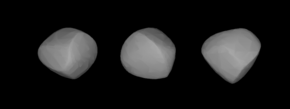 A three-dimensional model of 160 Una based on its light curve. A three-dimensional model of 160 Una based on its light curve. | |
| Discovery | |
|---|---|
| Discovered by | C. H. F. Peters |
| Discovery date | 20 February 1876 |
| Designations | |
| MPC designation | (160) Una |
| Pronunciation | /ˈjuːnə/ |
| Minor planet category | Main belt |
| Orbital characteristics | |
| Epoch 31 July 2016 (JD 2457600.5) | |
| Uncertainty parameter 0 | |
| Observation arc | 118.30 yr (43209 d) |
| Aphelion | 2.90877 AU (435.146 Gm) |
| Perihelion | 2.54727 AU (381.066 Gm) |
| Semi-major axis | 2.72802 AU (408.106 Gm) |
| Eccentricity | 0.066257 |
| Orbital period (sidereal) | 4.51 yr (1645.8 d) |
| Average orbital speed | 18.01 km/s |
| Mean anomaly | 144.472° |
| Mean motion | 0° 13 7.471 / day |
| Inclination | 3.82512° |
| Longitude of ascending node | 8.60989° |
| Argument of perihelion | 52.8418° |
| Earth MOID | 1.56031 AU (233.419 Gm) |
| Jupiter MOID | 2.30107 AU (344.235 Gm) |
| TJupiter | 3.349 |
| Physical characteristics | |
| Dimensions | 81.24±2.1 km |
| Mass | 5.6×10 kg (assumed) |
| Mean density | 2.0? g/cm |
| Equatorial surface gravity | 0.0227 m/s |
| Equatorial escape velocity | 0.0429 km/s |
| Synodic rotation period | 11.033 h (0.4597 d) 0.234 d (5.61 h) |
| Geometric albedo | 0.0625±0.003 0.063 |
| Temperature | ~170 K |
| Spectral type | C |
| Absolute magnitude (H) | 9.08, 8.95 |
160 Una is a fairly large and dark, primitive Main belt asteroid that was discovered by German-American astronomer C. H. F. Peters on February 20, 1876, in Clinton, New York. It is named after a character in Edmund Spenser's epic poem The Faerie Queene (1590). This minor planet is orbiting the Sun at a distance of 2.73 AU with an eccentricity of 0.07. The orbital plane is inclined at an angle of 3.83° to the plane of the ecliptic.
In the Tholen classification system it is categorized as a CX-type, while the Bus asteroid taxonomy system lists it as an Xk asteroid. Photometric observations of this asteroid made at the Torino Observatory in Italy during 1990–1991 were used to determine a synodic rotation period of 5.61 ± 0.01 hours. It has an estimated diameter of about 81 km.
References
- Benjamin Smith (1903) The Century Dictionary and Cyclopedia
- ^ Yeomans, Donald K., "160 Una", JPL Small-Body Database Browser, NASA Jet Propulsion Laboratory, retrieved 12 May 2016.
- ^ di Martino, M.; et al. (February 1994), "Lightcurves and rotational periods of nine main belt asteroids", Icarus, 107 (2): 269–275, Bibcode:1994Icar..107..269D, doi:10.1006/icar.1994.1022.
- "Lightcurves and map data on numbered asteroids N° 1 to 52225". Archived from the original on 27 November 2005. Retrieved 3 November 2008.
- "Infrared Astronomical Satellite (IRAS)". Archived from the original on 24 February 2005. Retrieved 24 February 2005.
- Asteroid Lightcurve Data File, Updated March 1, 2001
- Warner, Brian D. (December 2007), "Initial Results of a Dedicated H-G Project", The Minor Planet Bulletin, 34 (4): 113–119, Bibcode:2007MPBu...34..113W.
- "Numbered Minor Planets 1–5000", Discovery Circumstances, IAU Minor Planet center, retrieved 7 April 2013.
- DeMeo, Francesca E.; et al. (July 2009), "An extension of the Bus asteroid taxonomy into the near-infrared" (PDF), Icarus, 202 (1): 160–180, Bibcode:2009Icar..202..160D, doi:10.1016/j.icarus.2009.02.005, archived from the original (PDF) on 17 March 2014, retrieved 8 April 2013. See appendix A.
External links
- 2011-Jan-24 Occultation / (2011 Asteroidal Occultation Results for North America)
- 160 Una at AstDyS-2, Asteroids—Dynamic Site
- 160 Una at the JPL Small-Body Database

| Minor planets navigator | |
|---|---|
| Small Solar System bodies | |||||||
|---|---|---|---|---|---|---|---|
| Minor planets |
| ||||||
| Comets | |||||||
| Other | |||||||
This article about a C-type asteroid native to the asteroid belt is a stub. You can help Misplaced Pages by expanding it. |